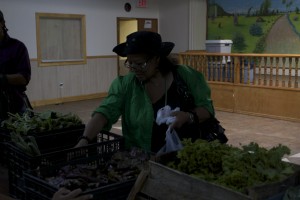The Hunts Point peninsula sticks out of the South Bronx mainland like a thumb. Defined by the East River to the south and the Bronx River to the north, this maze of scrap yards and warehouses is severed from the rest of the Bronx by the Bruckner Expressway.
However, hidden among the twisted metal and industrial rubble, behind a long concrete wall, is the largest food market in the world. Entry is $3 and all are welcome, but few apart from the industrious obsessives who run the market ever come. Even they are increasingly rare.
Mike Karan arrived at 6 p.m., four hours before the market officially opened. He followed his nightly ritual, weaving through the market’s 1 million square feet of warehouses, loading docks, and sales rooms, inspecting each seller’s inventory. A 30-year veteran buyer, Karan moved fast for a man pushing 50.
“There is no walking,” Karan shouted between breaths. “No eating. No sleeping. No rest.”
The market is organized into four long parallel rows of warehouses. Inside, tidy towers of produce line the walls. Boxes of Ecuadorian plantains from Ecuador sit across from bins of Texas watermelons from Texas. Over $2 billion worth of fruits and vegetables pass through the gates every year, according to the market’s website, feeding over 22 million people in a 50-mile radius around the market.1 However, all of the action happens in the middle of the night.
At midnight, Karan crouched in a frigid box car, examining blackberries. He investigated each row of boxes, peering into each plastic container with his iPhone flashlight, and tasting as he went. The plump berries were still reddish and tart. Some were touched by mold (a “gift” in market lingo). “The best are $32 a box, these are $12,” he explained, and at that price, a deal too good to pass up. Karan scribbled “SOLD” on a paper attached to the boxes and hurried on.
As Karan snaked through the warehouse, squeezing, peeling, smelling, tasting every item along the way, he created a mental inventory of the night’s offerings. Plump sweet-O pluots (a plum/apricot hybrid) from California with speckled yellow skin looked delicious but were too sour. Mandarin oranges from Peru peeled easily, but didn’t have a sticker. “Customers want to see a sticker,” Karan said.
Outside on the loading docks, the hot air carried the sour smell of composting produce. Errant tomatoes and apples, the casualties of hurried transport, lay crushed into the concrete. Workers in reflective vests, hauling pallets stacked with onions and cucumbers, weaved between one another on the narrow walkway. A novice might stay pressed up against the wall for fear of joining the tomatoes crushed underfoot. Karan walked down the middle of the dock, allowing the traffic to make way for him.
After making his selection from each seller, Karan headed for the sales office to complete his purchase. The entire process generally takes around eight hours, often keeping Karan at the market past 2 a.m.
Each of the market’s 35 sellers has at least one glass-enclosed sales office stationed along the loading dock. Rows of salesmen (they are all men) sit behind raised counters, punching orders into the computers in front of them and cracking wise to anyone within earshot.
“This is what I call jack-off hour,” a salesman named Joey Mush grinned through his walrus mustache. “Because all the customers are jack-offs.” A menagerie of gold charms, jumbled together on a single chain around his neck, jangled as he laughed at his own joke.
Mush is not his real last name. He doesn’t like people to know his real last name. And he’s particular about the pronunciation: “Not ‘moosh,’” he instructed, “mush, like mushroom.” The pronunciation make sense since Mush is the resident mushroom specialist at A&J Produce, one of the largest sellers in the market.
Mush has been at the market for over 40 years, first working with his father, then running his own business, before coming to work at A&J Produce. Like Karan, Mush is a total obsessive. His mind is constantly churning through data. Recently, Trump’s tariffs on Chinese imports had caused a shortage of peeled garlic. This week, the price of broccoli had spiked during the gap between the Canadian and Californian growing season.
The camaraderie and teasing between salesmen and buyers like Mush and Karan belies the gravity of their relationships. A single transaction can total thousands of dollars.Trust and reputation mean everything to these men.
But, just as necessary as characters like Mush and Karan are, they are also quickly becoming an anachronism.
These days, over 60% of orders that A&J Produce receives are placed over the phone for delivery, according to co-owner John Tramutola, Jr. These tele-buyers rely on Tramutola and his team to ensure quality, instead of visiting the market to inspect the goods in person. “Those days are over,” Tramutola said. “Nowadays everyone wants to stay in bed.”
And as the current salesmen age out of the industry, it isn’t clear who will replace them. “This isn’t a job for the young,” said Anthony G, a salesman at AJ Trucco, another larger seller in the market. “What young person is going to spend all night here?”
Whoever comes next, they will have to be just as obsessed and just as tough. “This is my life,” Mush said, reflecting on his career, before adding with a chuckle, “and I lament every night.”




